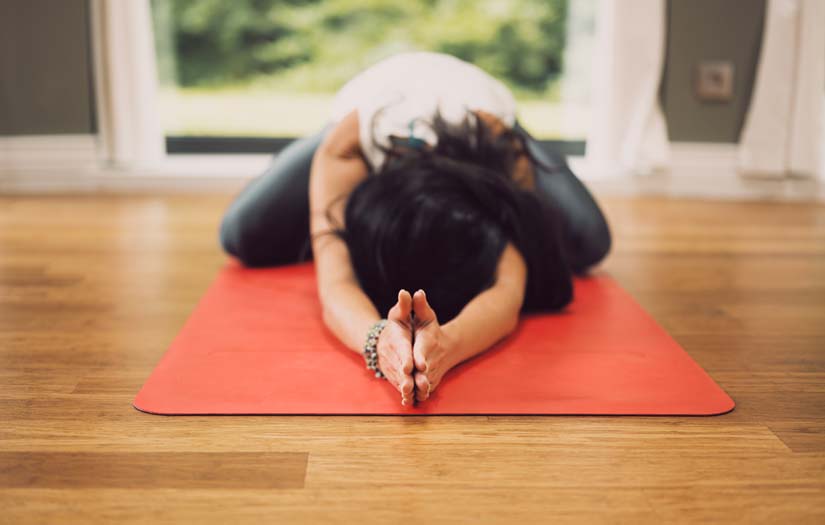Introduction of Asana and Meaning
Asanas are known as postures such as chakrasana or wheel posture, dhanurasana as bow posture and asanas belong to three basic postures of humans i.e. Standing, sitting and lying down but asana differs from posture in many aspects. Asanas are not postures.
Definition of asana according to Yoga Sutras
- Sthiram-Sukham-Aasanam (Patanjali Yoga Sutra)
- Sthira= Stable, steady, still
- Sukham= comfortable
An asana is that which contributes to stability and comfort.
Stability and comfort of what?
- Stability here does not only mean stability of the posture but also the stillness of body and mind as a whole.
- Even if we are physically stable in a posture, we may remain mentally unstable due to various disturbing sensory inputs. Only the stability of both body and mind together would lead to the sense of well-being.
- Not all postures that are easy to attain and comfortable to maintain are asanas.
- Asanas are those postures, particularly in a sitting condition, which lead to physical and mental stability and a sense of well-being.
Characteristics of Asana
- Stable.
- Comfortable.
- Stillness of mind.
- Sense of well-being.
- Effortlessness.
- Absence of tension.
- Minimum muscular activity.
- The absence of thought processes by contemplating on the infinite are the characteristics of asana.
Aims and objective of asana outcome of asana
- Equilibrium.
- Balance.
- Mastery over body organs.
- Perfect health.
- Harmony.
- Prepare for meditation.
- Mastery over the mind.

Classification Of Asanas
By the mode of performing yoga asana.
- Dynamic Asana
- Static asana
Dynamic Asanas
Dynamic asanas bring transformation in the structure of the body. As the name implies, the characteristics of this system of Yogasanas are speed and repetition.
Dynamic asanas involve the articulation of the spine: forward, backward, lateral, and twist.
While the physical exercises (Non-Yogic) are practical on the muscular, circulatory, and respiratory systems, they also affect the nervous and glandular systems.
The Dynamic Yogasanas stimulate energy. This energy combats laziness by shattering Tamas and gives rise to Rajas (activity). This particular system is recommended for children and people who are lethargic.
Static Asanas
- This system aims to develop an inner awareness and unfold the higher levels of consciousness.
- This system is characterized by continuity in movement (without jerks), slowness and maintenance of posture.
- This results in strength and forbearance-Titiksa. There is a proportionate body growth, resulting in deep relaxation and energy conservation, leading to a sense of freshness.
This process cultures the nerves which lead to calmness.
Classification of yoga asana
By effect of asana on anatomy-physiology.
- Cultural or corrective asana.
- Relaxative asana.
- Meditative Asana.
Cultural asana
Bring out changes in the body by correcting postural defects, corrects disturbed function of various systems, improper muscle tone and also cultivate correct mental attitude.
This group contains by far the largest number of asanas
The cultural asanas can be divided into seven groups:
- Dynamic sequences - such as the sun salutation.
- Inverted postures - such as the headstand.
- Forward bending postures - such as the sitting forward bend Paschimottanasana.
- Backward bending postures - such as the cobra, locust, or bow poses.
- Twisting postures - such as the half spinal twist.
- Side wards bending postures - such as the triangle pose.
- Standing postures including balancing poses - such as the tree pose.
Asanas for Relaxation
The asanas for relaxation are designed in a way that there is no need to contract any muscle. It is important to practice them exactly, so your body can come to a deep relaxation; it is not just lying on the floor.
There are three primary relaxation postures:
- Savasana or corpse pose.
- Abdominal relaxation pose.
- Garbhasana or child's pose.
Meditative Asana
These are cross-legged sitting postures which allow you to sit upright and relaxed for a longer time. They provide a stable seat for meditation without moving any part of your body. This is important if you are practicing meditation or pranayama. These postures increase concentration power and help in meditation.
- Padmasana or lotus
- Siddhasana or adept's pose
- Swastikasana or locked-ankles pose
- Sukhasana or easy pose

